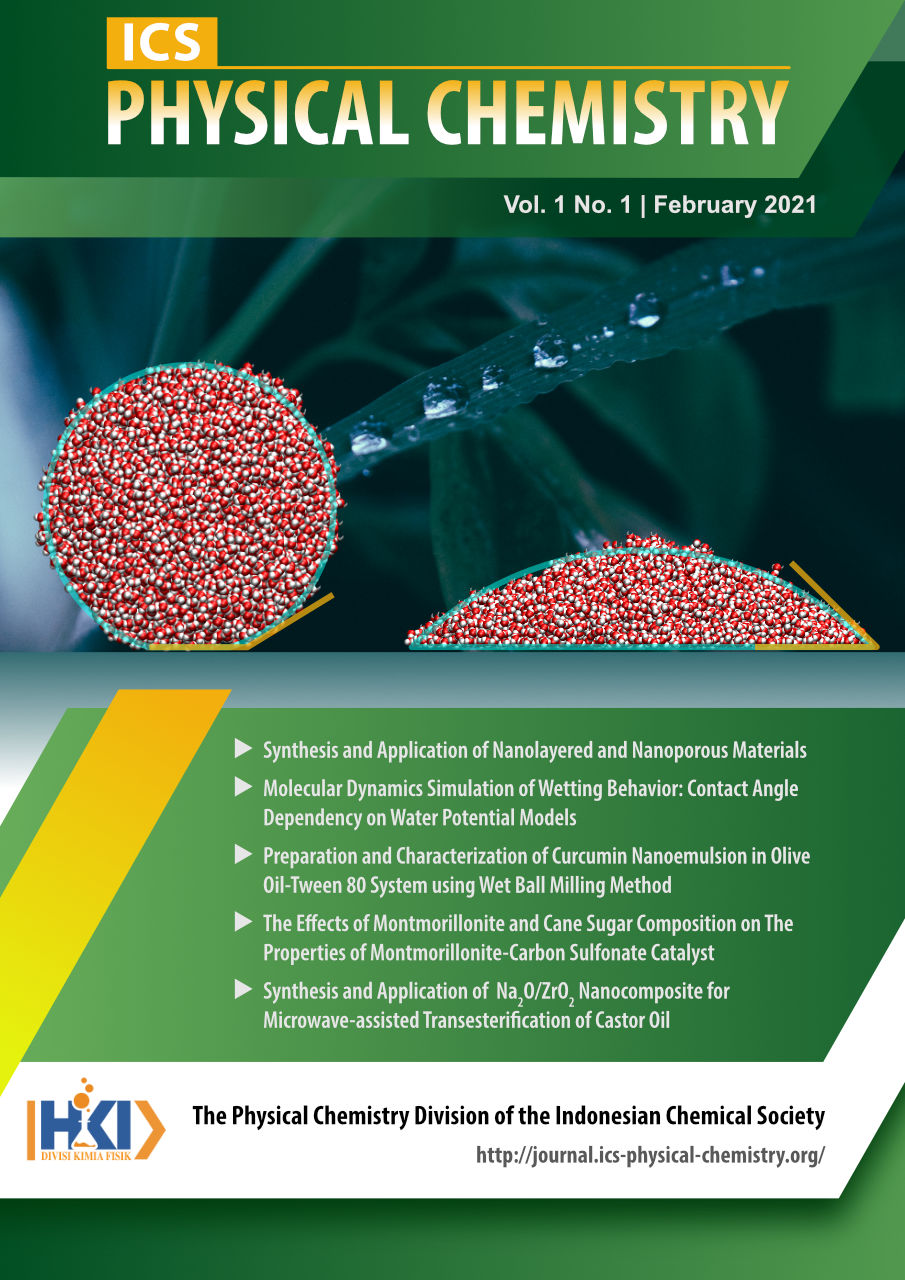The Effects of Montmorillonite and Cane Sugar Composition on The Properties of Montmorillonite-Carbon Sulfonate Catalyst
Main Article Content
Abstract
The influence of montmorillonite and cane sugar mixture with composition of 1:3, 1:2, 1:1, 2:1, and 3:1 to the characteristics of the synthesized montmorillonite-carbon sulfonate composite catalyst had been investigated. The mixture of montmorillonite and cane sugar was carbonized at 400 oC for 15 hours and then sulfonated using sulfuric acid at 175 oC for 15 hours. The presence of sulfonate group was detected using FT-IR and the surface topology of the catalyst was characterized using SEM-EDX. FT-IR spectra showed the existence of sulfonate group at wave number of 1095 cm-1. SEM-EDX analysis showed that the catalyst with the montmorillonite and cane sugar ratio of 1:2 consisted of 1.06% sulfur. The catalyst activity was examined using an esterification reaction between acetic acid and ethanol, and the reaction products were characterized using GC-MS. The chromatogram peak at m/z = 88 confirmed that the product was ethyl acetate. Catalyst with the montmorillonite and cane sugar ratio of 1:2 was shown to have the highest acidity and gave the highest esterification product with 76.97% conversion.
Article Details

This work is licensed under a Creative Commons Attribution-NonCommercial-NoDerivatives 4.0 International License.
References
D. Singh, D. Sharma, S. L. Soni, S. Sharma, P. Kumar Sharma and A. Jhalani, A review on feedstocks, production processes, and yield for different generations of biodiesel, Fuel, 2020, 262, 116553.
S. Kang, J. Ye and J. Chang, Recent Advances in Carbon-Based Sulfonated Catalyst: Preparation and Application, International Review of Chemical Engineering, 2013, 5, 12.
Y.H.Tan,M.O.Abdullah and C.Nolasco-Hipolito, The potential of waste cooking oil-based biodiesel using heterogeneous catalyst derived from various calcined eggshells coupled with an emulsification technique: A review on the emission reduction and engine performance, Renewable and Sustainable Energy Reviews, 2015, 47, 589–603.
I. F. Nata, M. D. Putra, C. Irawan and C.-K. Lee, Catalytic performance of sulfonated carbon-based solid acid catalyst on esterification of waste cooking oil for biodiesel production, Journal of Environmental Chemical Engineering, 2017, 5, 2171–2175.
F. Su and Y. Guo, Advancements in solid acid catalysts for biodiesel production, Green Chemistry, 2014, 16, 2934–2957.
P. Anadão, E. A. Hildebrando, I. L. R. Pajolli, K. R. de Oliveira Pereira, H. Wiebeck and F. R. Valenzuela Díaz, Montmorillonite/carbon nanocomposites prepared from sucrose for catalytic applications, Applied Clay Science, 2011, 53, 288–296.
J. Emrani and A. Shahbazi, A Single Bio-based Catalyst for Bio-fuel and Bio-diesel, Journal of Biotechnology & Biomaterials, 2012, 2, 1–7.
Y. Lu, X. Liang and C. Qi, Synthesis of novel carbon/silica composites based strong acid catalyst and its catalytic activities for acetalization, Bulletin of Materials Science, 2012, 35, 419–424.
S. Suganuma, Studies on Catalysis of Amorphous Carbon with Sulfonic Acid Groups, PhD Thesis, Tokyo Institute of Technology, Tokyo, Japan, 2012.
A. Aldana-Pérez, L. Lartundo-Rojas, R. Gómez and M. Niño- Gómez, Sulfonic groups anchored on mesoporous carbon Starbons-300 and its use for the esterification of oleic acid, Fuel, 2012, 100, 128–138.
F. Ezebor, M. Khairuddean, A. Z. Abdullah and P. L. Boey, Oil palm trunk and sugarcane bagasse derived heterogeneous acid catalysts for production of fatty acid methyl esters, Energy, 2014, 70, 493–503.
D. Dwi Anggoro, R. Rispiandi and P. Purwanto, Hydrolysis of Eichhornia crassipes (eceng gondok) to glucose over sulfonated active carbon catalyst, Malaysian Journal of Fundamental and Applied Sciences, 2015, 11, 67–69.
L. Efiyanti, D. A. Indrawan, Z. Arif, D. Hutapea and A. D. Septina, Synthesis and Application of a Sulfonated Carbon Catalyst for a Hydrolisis Reaction, Indonesian Journal of Science & Technology, 2020, 5, 410–420.
L. Hu, L. Lin, Z. Wu, S. Zhou and S. Liu, Chemocatalytic hydrolysis of cellulose into glucose over solid acid catalysts, Applied Catalysis B: Environmental, 2015, 174-175, 225–243.
